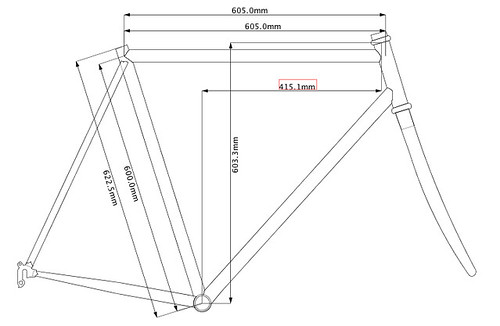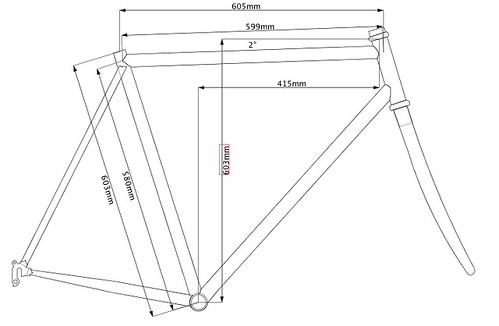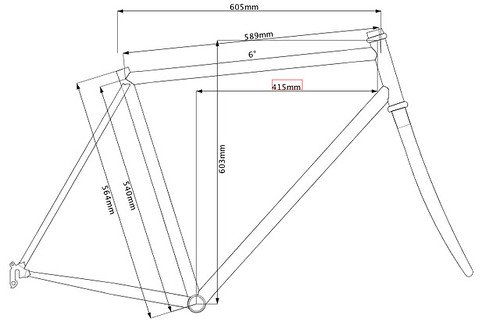By blackmountaincycles,
Filed under: Uncategorized
Recently I sold a frameset to a Bay Area resident. He’s also a member of an on-line bicycle related group. After he picked up the frame and set about building it, he sent me the link of this review of the frame. The summary of his first ride report was summed up with these two words: “Pure win.” Works for me and thank you!
Further down the comment list to this post, there were comments about frame sizing and wishing I would have made frames in 2cm increments instead of 3cm. I would have preferred to do that as well, but I couldn’t afford to have produced that many frames and stock that many sizes, initially. I may make some changes in the future. It is wise to start off small and modestly.
Regarding the sizing and how frames are sized, it’s all over the board and I do agree there should be some consistency. There is, however, consistency in the main dimension that I am most interested in how a bike fits me: top tube length. Effective top tube length, that is, since most frames these days have sloping top tubes. Back when all frames had horizontal top tubes, frame sizing was center-to-top or center-to-center. That’s center to the top of the top tube or center to the center of the top tube. However, as soon as top tubes started sloping, there was no one consistent angle to the sloping top tube and frame size numbers started receding.
During this time of shortening seat tubes, I still rode a frame with a top tube length at least 60cm long. I personally don’t mind if my frame has a horizontal or sloping top tube – as long as my three contact points (seat, bottom bracket, handlebar) are where I need them. Well, where I need them without going to extreme measures to get them there. On a road bike, I’ll use between a 12cm and 14cm stem and usually a 300-350mm length seat post with an inch of offset.
Even though the standard size determination on frames through the horizontal top tube years was the c-t dimension (center to top of top tube), when I created a complete line of frames that featured sloping top tubes for Masi years ago, I kept the c-t size designation by designing the frames based around a theoretical horizontal top tube, even though the top tube sloped and the actual size was smaller. It made sense to me.
Now that I have my own frames, I called out the sizes based to the actual length of the seat tube, center-to-top of seat tube. The top tubes have about a 2 degree slope to them so the traditional center-to-top of top tube dimension yields a smaller frame. On all the frames, there is 25mm of seat tube extending above the top tube. So, if you want a c-t dimension, subtract 2.5cm from my frame size. I ride the 62. The c-t dimension would be 59.5. However, saying that it’s a 59 (rounding down) gives a false impression of the actual size of the bike when it’s not taken along with the top tube length (605 in this case). It’s my decision. I try to make sure it’s clear by spelling out that the size is the length of the seat tube.
Recently, some folks have tried to create a new method of sizing a frame: Stack and Reach. This system cares not if your top tube slopes. If you know your ideal stack and reach, then it’s simply a matter of picking the frame size based on the closest stack and reach to your bike fit. I’ve thought about including stack and reach in my geometry chart and may add it at some point, but definitely will include it with any new frames I bring to market.
While pondering this post, I composed a little visual based on three frame drawings of what is, essentially, the same frame size. The only difference is the length of the seat tube and therefore what the size of the frame may be considered. Even with fairly significant changes in the frame “size” (seat tube length), the Stack and Reach remain exactly the same.
This drawing shows a frame with a horizontal top tube and a seat tube of 60cm center-to-center. Stack is 603.3mm, reach is 415.1mm.
This frame is sporting a 2 degree sloping top tube (like my frames). Seat tube is now 580cm. Stack and reach remain unchanged.
This next one has a more dramatic slope to the top tube. Seat tube of what was a 60cm c-c frame is now down to 54cm and the actual top tube length has been reduced by 16mm. Stack and reach are unchanged.
What I’m seeing when I see these images are dramatically shortened tubes. Lopping 16mm off a top tube and 60mm off a seat tube can result in some decent weight savings. Hmmmm…not that I’m a weight weenie, but …
« Prev
650b conversions…
650b conversions…
Next »
Quick, release…
Quick, release…




Mike, thanks for this post. I think Stack and Reach is about as confusing as the rest of the "systems" used for frame sizing. In your example here, you show very well exactly why I don't like Stack and Reach. It doesn't tell me what I want to know completely.
The one thing Stack and Reach do not address is seat tube angle, which is crucial to me. I have a certain seat set-back relative to the bottom bracket that is only achieved with a fairly shallow (by today's steep seat angle standards) seat angle and a set back seat post. This combination of angle and post design let me achieve my setback without slamming the seat all the way back or forward on the rails (hate how those look).
It just shows that the whole picture of the bikes geometry numbers are needed to adequately figure out the frame fit for each individual.
Agreed…. TT figures need to be looked at in conjunction with STA or they are almost meaningless. I have found that often very experienced bike people miss this concept and give you a blank stare when it is pointed out to them.
If you have the reach and you have the top tube length, you can calculate the setback. With setback and stack as two sides of a right triange, you can also calculate seat tube angle.
I've read that some builders, Sachs being one of them, use setback only and don't work with seat tube angles at all.
Same result, different ways to get there.
Rich F.
True. When I built my one and only frame (with guidance from a frame builder and someone who is just plain knowledgeable), I started with the seat tube and built off that. I know many frame builders start with the bb shell and the seat tube in the jig first.
It all shows that there are a lot of different ways to skin a horse, but knowing additional numbers in addition to stack and reach help. Personally, I didn't know what the stack and reach were for the frame I'm riding before conducting the experiment with those frame drawings and I probably won't commit those numbers to memory like I do with setback and saddle nose to bar.
The stack number seems like the more valuable of the stack and reach dimensions, because it allows you to consider handlebar height without having to take the bb drop, headtube length and fork length into account.
Reach on the other hand seems basically useless because as Mike pointed out, you are still going to need to get an approximation of saddle setback which is a combination of seat tube angle, seatpost offset and saddle rail dimensions and personally I would rather just look at the seat tube angle and effective top tube dimension and leave the "reach" out of it.
Stack and reach would be nice to know (in addition to the other "traditional" measurements) when comparing frames. It seems like it's the most consistent indicator of frame size – although not a full picture for sure.
I tend to pay attention to the combo of TT length and STA, plus the head tube length. However, lately with the new integrated headsets it's become more difficult to use the head tube length – the stack measurement would help with that.
In any case, it's a nice post. I have friends that ask me, "what size frame they should be riding, a 56cm?" All I can answer is that I have frames that are described by the manufacturer as being anywhere from 54 to 60cm and they're all virtually the same size. In the future I'll point them to your post. 🙂
Understanding the limitations of the stack and reach measurements, it would still be helpful to know this in choosing a frame size from a geometry chart. For example, I am seriously considering the Monstercross frame and would like to be able to compare reach and especially stack values to those of the bikes I ride now. Specifically, the 59 size with the 58cm ETT.
The 59 cross frame has a stack of 598.4mm and a reach of 396.3mm.
Feel free to e-mail or call me if you have any other questions.
As the recent customer that gave the ride report: "Pure Win", let me also say that Mike was extremely interactive and helpful in my deliberations on getting my setup on the 59 dialed. My approach is to get as close as possible with frame numbers and kind of converge on the setup details over hundreds of miles and weeks of riding. With Mike's assistance I think we set up my bike spot on perfect from mile 1. The only thing I've tweaked is saddle tilt. Anyone mulling over Mike's geo chart I urge you to get Mike personally involved. I'm confident that in that interaction you'll either get a bike that is PERFECT for you, or he'll tell you it can't be done with his frame.
Thanks, Bubba!
Sorry this is late, but I just wanted to add that I'd love for stack and reach to become a new standard. I made a small drawing a while ago that can help to illustrate why going by seat tube length and top tube length can be very deceiving.
http://www.flickr.com/photos/jimmythefly/6326849846/in/photostream
Someone saw it and made an even better animated gifseen here:
http://www.biketinker.com/2011/bike-resources/bike-fit-geometry-relationships/
Thanks for the blog, always enjoy it!